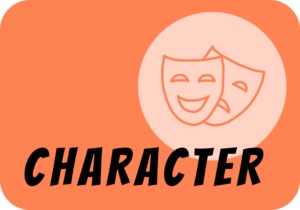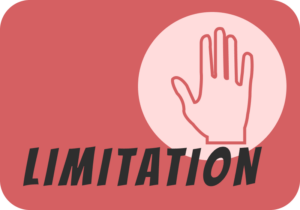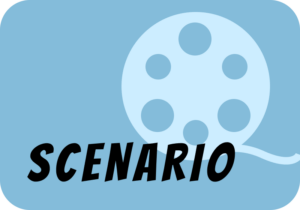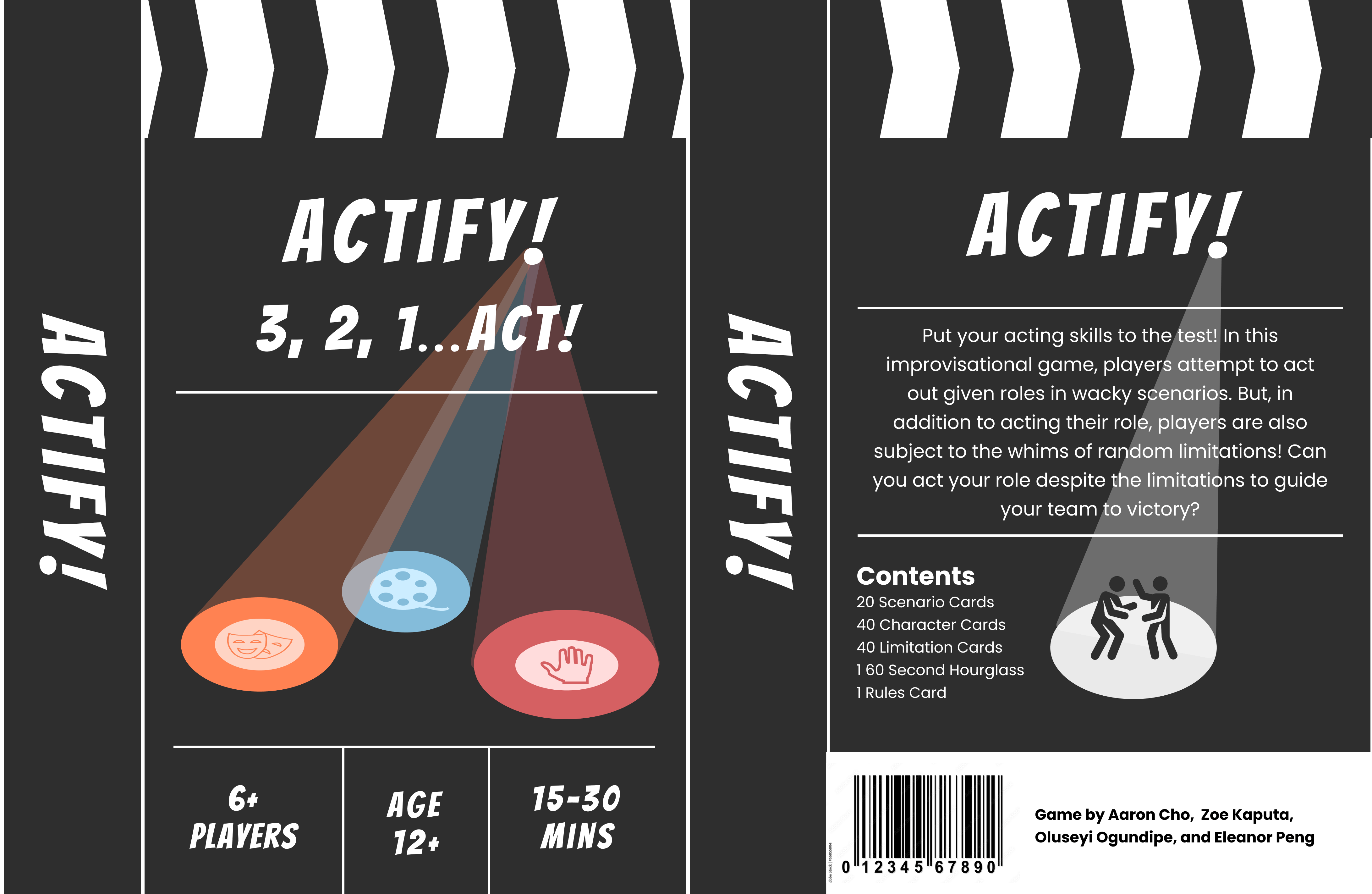Artist’s Statement
Actify is a game that inspires players to become comfortable with each other through improv acting together. Actify was inspired by the age-old game of charades and how its easy-to-follow mechanics produce an energized dynamic during gameplay. Although Charades is fun for players, most of its fun comes from the challenge of guessing and acting out prompts. We designed Actify to extend the fun of Charades to also be based on one’s fellowship with the other players and the narratives that improv can create, while still maintaining Charades’ energy and movement.
Now, instead of acting out a prompt by yourself, you and another player on your team work together to get your team to guess what scenario you are acting out, the characters both of you are acting as, and the limitations you and your partner are abiding by. Improvisational acting is a vulnerable and sometimes scary feat, but by having the support of one’s acting partner and team, players will gain trust in each other. We are hoping that players will use Actify to become more comfortable with their friends and acquaintances, along with practicing their improvisational skills.
Concept Map
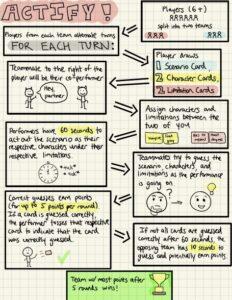
Formal Elements and Values
Game Values
We began our development process by discussing the values that we wanted players to experience in Actify. Although these values changed slightly in form during the interaction and development process, our goals throughout were for players to (1) be introduced to the art of improvisation in a fun and comfortable manner and (2) generate trust with their teammates.
- Introduction to Improv: The art of improvisation can be a daunting practice to learn. By presenting in a short, gamified context, we hope to give players a space to learn the basics of improv, letting them find fun in the narratives they produce. This sensuality of play is a key need for us as humans, and our game inspires it in an informal context.
- Trust Generation: As a form of fun through fellowship, we are aiming for the mechanics of our game to inspire affiliation (trust and comfort) between players. This is done mainly by putting characters in absurd scenes with each other.
Initial Versus Final Formal Elements
Our initial idea for Actify was for it to be a game based on confronting common ethical dilemmas in groups. Although our game has greatly transformed since then, many of our original formal mechanics are still relevant. They are listed below.
Players: Our game uses a team vs. team format. This decision was aimed to inspire a dynamic of camaraderie between players and their teammates. This format ended up being successful; we also used a team vs. team structure in our final game.
Objectives: The main objective of our game was originally to guess the characters that players were acting as in an ethical scenario, along with what character they were acting as, in order to gain points. Through our interactive process, this objective ended up still being solution-oriented, where players have to guess the characters their teammates are acting as, the limitations each actor has, and the scenario they are acting in. The actors have the objective of constructing their given scenario from the point of view of their characters, while also sticking to their limitations.
Procedures and Rules:
- Players are split into two teams.
- Players from each team alternate turns acting out a scene as specific characters.
- Each turn proceeds as follows:
- One player and the player to their right on the acting team are acting. All other players on their team are guessing.
- The pair draws a scenario card, and each player acting draws a character card. They tell all players the scenario card, but not their character cards.
- The pair has one minute to act out their response to the ethical dilemma as their given characters. Their team tries to guess the acting pair’s characters while they are acting. As soon as they guess a character correctly the actors can confirm.
- If the team cannot guess both characters in the one minute time period, the other team has one guess (per unguessed character), to “steal” from the team.
- Each character guessed correctly is one point for the team that guessed (whether through guessing directly or through stealing).
- Subsequent rounds switch between teams, and the players acting rotate clockwise.
- The team with the most points after 5 rounds wins.
After many iterations of playtesting, we refined this original idea and came up with a new set of rules. They are listed below. Please see the “Testing and Iteration History” section for details on our design decisions here.
- Players are split into two teams.
- Players from each team will alternate turns, acting out a scenario and trying to have their team guess the scenario, characters, and limitations that they are acting out.
- Each turn proceeds as follows:
- A player draws a scenario card, two character cards, and two limitation cards.
- The teammate to the right of the player will be their co-performer.
- Together, the pair acting chooses which player will be which character and which will have which limitation while acting out the scenario.
- The cards are not to be revealed to non-performers.
- The performers have 60 seconds to act out the scenario as their respective characters under their respective limitations.
- Their teammates try to guess the scenario, the characters, and the limitations, while the performers are acting.
- When a card is guessed correctly, the performer with that card throws it on the ground to indicate that it was guessed.
- Correct guesses earn points (up to 5 points per round).
- If not all cards are guessed correctly after 60 seconds, the opposing team can steal points with a 10-second guessing period.
- The team with the most points at the end of 5 rounds wins.
Resources: In our original design, the performers were able to use their dilemma and character cards as resources in the acting process, and all players had to use the resource of time wisely. In the final version, players have slightly more resources. The performers have scenario, character, and limitation cards as resources. To enable players to view time visually without introducing distraction, we also include a 1-minute hourglass. And again, teams must use time wisely to act and guess.
Boundary: The boundaries of the game are the physical space (e.g. room or area) that the game is being played in. Players can move around this space as they act and guess. This is the same boundary that we are using in the final version of the game.
Outcomes: The outcome of the game is that one team wins and the other loses, depending on who has the most points at the end of the game. This is the same outcome mechanic used in the final version of the game.
Testing and Iteration History
Iteration 1: Ethical Dilemmas and Characters
We began testing our game nearly immediately, with our very first prototype being made in class on April 11th. We used the cards given in class to quickly make the very first cards of the game, shown in the image below. There were only two dilemmas and 12 characters. At this time, we were still debating whether or not to guess the ethical dilemma or the actors’ response to the situation and wanted to begin answering that question with this prototype. As such, we chose to test out just guessing the characters. We were able to get two quick rounds in, and instantly had some laughs and fun playing the game just amongst ourselves there. From this, we identified that the strength of the game was the improvisational element and setting up wacky situations.
Feedback and Edits
- Our initial concept of focusing the game on ethical dilemmas and scenarios quickly went out of the window at this time, in favor of just pure scenarios. We decided to just showcase scenarios and then guess characters.
- We came up with the idea of adding limitation cards to spice things up and make things harder to guess, and floated the idea of perhaps adding setting cards as well, just to create good scenes to build off of for improvisation.

Iteration 2: Enter Limitations
Our team met to create a prototype for the class to play for the checkpoint on April 15th, 2024. The main purpose of this prototype was to add limitations to the mix and observe their effects on the game. A discussion we had was that with the added element of being able to talk as opposed to a game like Charades, there needed to be some element that made things more difficult for the guesser, and thus we came up with limitations. That, and it seemed hilarious to make an actor end every one of their sentences with “meow”. This was also when we established how the game would operate for teams, though in all our tests at this point we were only able to test as one team. It was decided that each team would have actors and guessers, and the other team would get a chance to steal after the acting time was up, getting one guess for each unguessed role. For this test, we played two rounds. One thing we immediately noticed after the first round was that it was better to allow players to draw two character cards and choose which one seemed more fitting for the scenario and/or limitation. All of us enjoyed playing with the limitations, and we were ready to showcase our prototype to our fellow classmates.

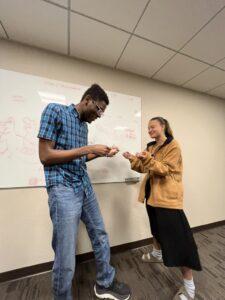
Feedback and Edits
On April 16th, we playtested the game in class with our fellow classmates. Overall, they had fun! However, they exposed some issues and flaws with the game that we needed to address.
- At the time, we had characters such as “Yoda”, “Justin Bieber”, and “Simon Cowell” in the deck. The fact that some characters were general such as “vampire” and then these specific ones were also thrown in led to players being confused as to what types of characters they should be guessing. We decided to remove these specific characters.
- Some limitations were so involved that they became whole characters in and of themselves, which meant they would be guessed instead of the actual characters. Limitations such as “You’re vegan and you need to make it known”. These were all removed.
- Having 30 seconds of discussion before acting dragged out the game and went against the improvisational spirit and energy of the game. We made a big change and decided to have no discussion time once the actors decided and show each other their characters.
- We wanted the game to have scenarios involving variable numbers of people, such as solo scenarios and 3+ people scenarios (certain scenarios utilized the term “everyone”, which meant more than two people could act in them). At the table, it quickly became apparent that the game was much simpler and still fun if every scenario involved just two actors, so we removed the solo scenarios.
Iteration 3: Guessing and Scenario Issues
On April 18th, 2024, we were able to do another playtest in class with the edits from earlier implemented. The game had a better flow with the 30 seconds of discussion removed and the consistency of the character cards. In addition, the limitations added to the fun and laughter of the game instead of making it more difficult to guess the characters after we pruned the problematic ones. At this point, we were fairly confident with the game but core issues regarding the guessing mechanic and the scenario were now pushed to the forefront with other issues having been solved.
Feedback and Edits
- People enjoyed how general the characters were, though some expressed concern that some were actually too easy to guess. Since it was easy, we decided to implement the idea of also guessing limitations as well for the next iteration.
- We observed that people sometimes strayed away from the initial scenario prompt or effectively ignored it entirely, bringing to attention how we wanted to handle scenarios. For now, we kept them the same in the next iteration.
- Several issues with the guessing mechanic are more prominent now. People did not always realize they could guess during an act, and some expressed that having to respond to the guesses during the improv could get in the way of the act. We considered having people wait until the end to guess, but decided against it for the time being.
Iteration 4: Guessing Characters and Limitations
The next iteration was tested three times between April 23rd, 2024 and April 24th, 2024. We tested two times in class on April 23rd and then had an additional playtest on the 24th. We made one crucial change in this iteration to test for now: limitations had to be guessed in addition to characters. This change worked out well for the most part though it had some kinks, but the issues of guessing mechanics and scenarios remained and we, in addition to our playtesters, were split on them.
Feedback and Edits
- Players were confused about what a limitation card looked like when attempting to play the game by the rules alone, which made the first round of guessing them extra difficult. To alleviate this, we added a quick rule to showcase a character and limitation card when first starting.
- There was a varying level of difficulty between iterations. Some, such as “meowing at the end of every sentence” were easy to guess while others such as “act nonchalant” were never guessed. We decided to curate the limitations somewhat, but decided that it was ultimately okay for some of them to be more difficult than others.
- When it came to the guessing mechanics, one of our playtest groups felt it was disrupting the actors to guess during the act, while the other thought it was more fun and engaging to guess during the act and referred to another game they had played in which they did not like having to wait to guess. As somewhat of a middle ground, we came up with a rule that the actors would throw their card out to the side if it was guessed, but kept acting, so as not to make the guesses as disruptive.
- A new problem that emerged with some characters being guessed fairly quickly was that the players stopped committing to the character or limitation for the rest of the act; usually switching over to highlight whatever their other unguessed card was if they still had one. In the worst case, one actor would stop acting entirely once both their cards were guessed, which went against our goal to foster improv and fun between the duo.
- Players felt it was simpler to let the acting duo choose who was X or Y in the scenarios instead of assigning it by birthdate, a change which we quickly acquiesced to. In addition, scenarios continued to have no great purpose in these playtests. Some players liked having them as a starting point for an act, but others did not heed them at all. We decided to make the scenario something that had to be guessed as well in our final iteration.
- The stealing mechanic felt awkward and unwieldy with the stealing team getting a certain amount of guesses on each unguessed card. Players were confused about when a guess was “locked in” or not and suggested that we simply give the stealing time a limited amount of time after the act to attempt to steal. For the next iteration, we decided to give the stealing time 5 seconds to say as many guesses as they wanted for the steal. Stealing also became much more viable as a result of there being 4 things to guess (2 characters and 2 limitations) instead of just 2, so we did see the mechanic actually come into play in these tests which we had not really seen as much before.
- People usually avoided saying the words on their cards, but sometimes got very close to it. There was an unspoken rule to not directly say the word on your card, but similar words became a gray area for the players and us. We at least decided to make it a formal rule that someone could not say the words on their card.

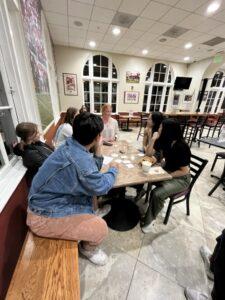
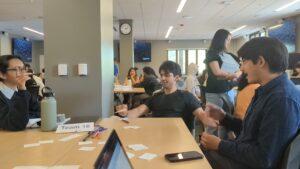
Final Prototype
Iteration 5: The Final Act
We were able to host one small final playtest with the final iteration on April 25th. In this playtest, there was only one team of three. We went through the full rotation of 2 actors and a guesser amongst this team, and had them additionally guess scenarios as well as characters and limitations. This brought the grand total of things to guess during a round to 5.
Feedback and Potential Future Directions
- Guessing the scenario was well-liked and went smoothly, and encouraged players to interact with each other and the scenario a bit more since they involved both people. However, sometimes, it still felt like people were yelling at the guesser instead of acting with each other. We would like to make more limitations and scenarios that nudge people towards interacting with their partner actor to sell a cohesive act, instead of two actors acting out individual bits.
- Throwing the card to the side once it was guessed kept the actors more focused and less disrupted by people guessing during the act.
- We decided to let one person draw two character cards and have them and their partner choose which character to act as, instead of both drawing two character cards each. This lessened the conferral time between the actors before an act began which improved the game flow.
Playtest Video
Click here to access playtest video.
Print and Play
Printable version (PDF| Figma)
For our final design, we decided to go with a movie theme with bright colors to highlight the acting aspect of our game. The box design resembles a clapperboard and each card resembles a film reel, as if each round itself is a unique film. The vibrant card colors accentuate the energy of Actify, encouraging players to be bold with their improv. By using different colors for Scenario, Character, and Limitation cards, we also hope to help users differentiate the decks quickly during the short 1-min acting session.
Box Design
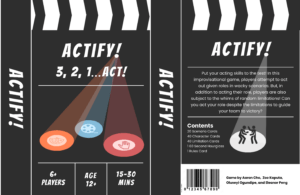
Rule Sheets
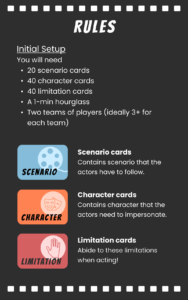
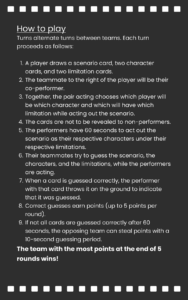
Cards
